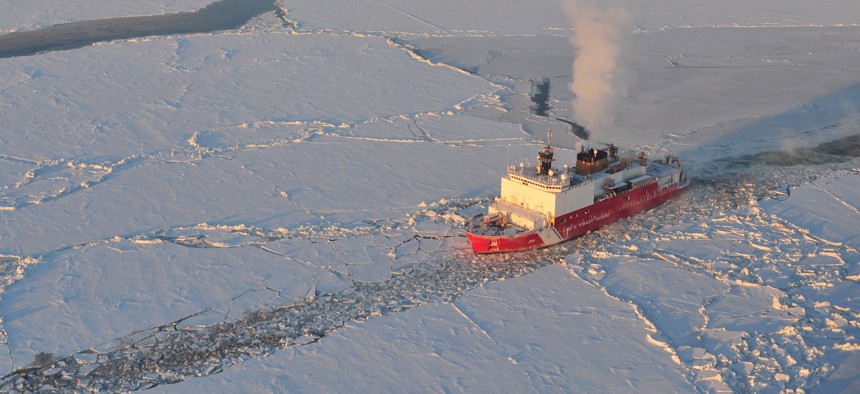
In this 2006 file photo, the U.S. Coast Guard cutter Healy breaks ice for the Russian tanker Renda near Nome, Alaska. U.S. Coast Guard / Petty Officer 2nd Class Charly Hengen
The Dangerous Myth of an 'Icebreaker Gap'
The U.S. fleet of icebreaking ships is already too small to handle its Arctic duties. Don't stretch it further with a made-up military mission.
America is finally taking steps to fix its woeful shortage of icebreakers, the armor-bowed vessels that enable year-round presence and passage through the ever-more-important Arctic region. But U.S. officials increasingly think and talk about these ships as defense assets, and that’s not in our best interest.
It’s common among those who concern themselves with Arctic policy to talk about an “icebreaker gap.” In past years, this has generally referred to the difference between the number of such ships operated by the U.S. Coast Guard versus the number needed to adequately attend to the American Arctic. This gap is real. Currently, the service operates one medium and one heavy icebreaker (a second has been dockbound for more than half a decade). USCG studies, however, say three of each would be needed to adequately provide emergency response and law enforcement services and maintain supply lines.
Though it is worth noting that the service’s vice commandant has put forth that two heavy icebreakers would suffice, no one disputes that the USCG is presently ill-equipped to respond to emergent situations, whether they involve a supply or health emergency in an Arctic community, an environmental or cruise ship disaster, or a sharp uptick in northern shipping. Thankfully, both the President and members of Congress have been persuaded to add $1 billion for a new heavy icebreaker to a proposed bipartisan funding bill. The USCG acquisition corps will also get help from their more-experienced colleagues at the Navy.
Recent icebreaker enthusiasm, however, has become infused with problematic motivations, ones that risk substantial waste and even national security concessions once any new vessel comes into service. This can be seen in a newly popular definition of the “icebreaker gap”: the observation that America’s tiny fleet is dwarfed by that of Russia, which already has more than 40 icebreakers and plans to add more.
Many have sounded alarm bells, saying that this places the country’s national security in jeopardy, envisioning the Arctic as an arena where states will compete intensely for resources and even territory. America’s relatively deficient icebreaking capability, they say, will keep the country stuck behind a frozen wall as Russia follows its massive icebreaker fleet to conquest and riches.
These assertions are largely erroneous. First, there is no “race for the Arctic.” The region’s states are only pursuing resources within their jurisdictions and have agreed to settle territorial disputes according to the relevant provisions of the United Nations Convention on the Law of the Sea (UNCLOS). Second, Russia possesses significantly more Arctic territory and coastline that the U.S., and a comparatively massive Arctic economy and population. Consequently, there is considerably more shipping across Russian Arctic waters, which necessitates a considerably larger icebreaker fleet. That is, its massive icebreaker fleet is not meant to conquer the Arctic, but to safeguard and facilitate commerce in the Russian Arctic. And third, Russia’s icebreakers would not appreciably affect U.S. Arctic security even if Moscow desired to act belligerently. Other than leading surface warships through icy waters or facilitating northern military resupply missions—neither task being required by the U.S. military and, even if needed, both easily undertaken by redeployed icebreakers principally used for other purposes—these vessels make no appreciable defense contributions. Theoretically, icebreakers could lead surface warships into combat in icy waters, but the warships would be limited to paths cleared and be easy targets for submarines or other aerial or land-based weapons.
The real danger of this purported U.S.-Russia gap is to good U.S. defense policy. Advocating U.S. icebreaker procurement to reach military or other geopolitical ends risks the ships being inefficiently designed or actually used for defense purposes once built, roles for which they are unfit and that could draw the limited number of U.S. icebreakers away from the tasks for which they are needed and the communities that rely on them.
As Congress finally makes progress toward funding a new heavy icebreaker and the USCG finalizes the design for such a vessel, policymakers must resist the temptation to view this problem through an us-vs.-them lens rather than producing and deploying ships to meet actual and pressing needs.
NEXT STORY: The United Nations: What's the Point?




